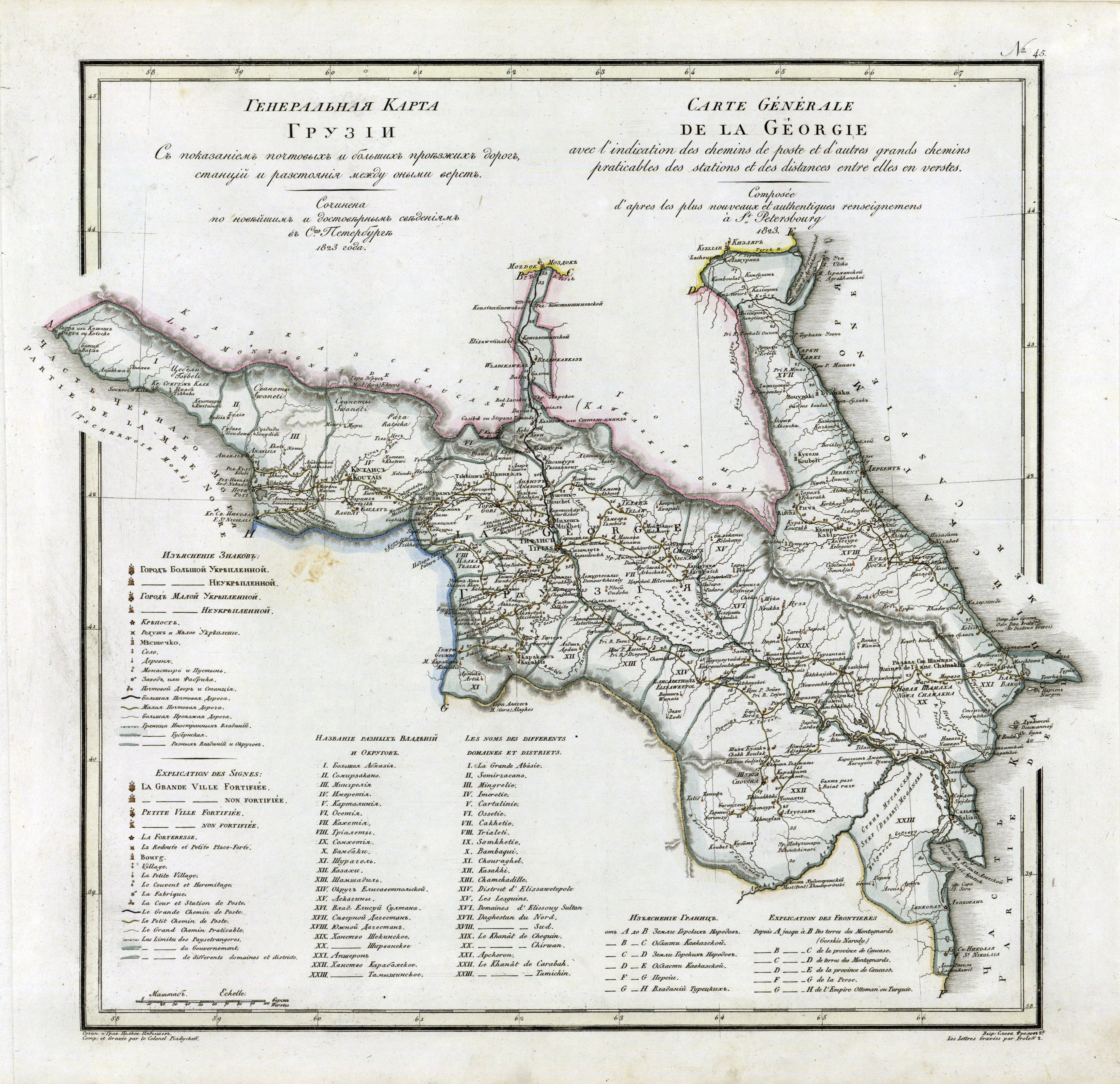|
Catholicos-Patriarch Of All Georgia
Catholicos-Patriarch of All Georgia ( ka, სრულიად საქართველოს კათოლიკოს პატრიარქი) is the Archbishop of Mtskheta and Tbilisi and the head of Georgian Orthodox Church. The official full title is ''His Holiness and Beatitude, Catholicos-Patriarch of All Georgia and the Archbishop of Mtskheta and Tbilisi''. The incumbent Catholicos-Patriarch of the church is Patriarch Ilia II since 1977, who is also the Metropolitan Bishop of Bichvinta and Tskhum-Abkhazia. ''Catholicos-Patriarch'' has been the title of the heads of the Georgian Orthodox Church since 1010, shortly after the unification of the Kingdom of Georgia. The first Catholicos-Patriarch of All Georgia was Melkisedek I (1010–1033). In the 15th century, with the collapse of the Kingdom, the Georgian Orthodox Church was divided into the East and the West parts and accordingly they were ruled by the ''Catholicos-Patriarch of East Georgia'' and the ''Cat ... [...More Info...] [...Related Items...] OR: [Wikipedia] [Google] [Baidu] |
Unification Of The Georgian Realm
The unification of the Georgian realm ( ka, ქართული სახელმწიფოს გაერთიანება, tr) was the 10th-century political movement that resulted in the consolidation of various Georgian crowns into a single realm with centralized government in 1008, the Kingdom of Georgia, or ''Sakartvelo''. It was originally initiated by the powerful local aristocracy of the '' eristavs'', due to centuries-long power struggles and aggressive wars of succession between the Georgian monarchs, arising from their independent ruling traditions of classical antiquity and their Hellenistic-era monarchical establishments in Colchis and Iberia. The initiative was supported by David III the Great of the Bagrationi dynasty, the most powerful ruler in the Caucasus at the time, who would put prince royal Bagrat, his kin and foster-son, on the Iberian throne, who would eventually be crowned King of all-Georgia. David's Bagratid successors would become the ... [...More Info...] [...Related Items...] OR: [Wikipedia] [Google] [Baidu] |
Catholicate Of Abkhazia
The Catholicate of Abkhazia ( ka, აფხაზეთის საკათალიკოსო, tr) was a subdivision of the Georgian Orthodox Church that existed as an independent entity in western Georgia from the 1470s to 1814. It was headed by the Catholicos (later, Catholicos Patriarch), officially styled as the Catholicos Patriarch of Imereti, Odishi, Ponto- Abkhaz-Guria, Racha- Lechkhum-Svaneti, Ossetians, Dvals, and all of the North. The residence of the Catholicoi was at Bichvinta (now Pitsunda) in Abkhazia (hence, the name of the Catholicate), but was moved to the Gelati Monastery in Imereti in the late 16th century. In 1814, the office of the Catholicos of Abkhazia was abolished by the Russian Empire which would take control of the Georgian church until 1917. History The date when the Catholicate of Abkhazia was established is not completely clear with some scholars dating it to the 9th or 10th centuries. [...More Info...] [...Related Items...] OR: [Wikipedia] [Google] [Baidu] |
Glorification
Glorification may have several meanings in Christianity. From the Catholic canonization to the similar sainthood of the Eastern Orthodox Church to salvation in Christianity in Protestant beliefs, the glorification of the human condition can be a long and arduous process. Catholicism The Catholic Church teaches that, "at the end of time, the Kingdom of God will come in its fullness. After the universal judgment, the righteous will reign for ever with Christ, glorified in body and soul. the universe itself will be renewed. ..The visible universe, then, is itself destined to be transformed, 'so that the world itself, restored to its original state, facing no further obstacles, should be at the service of the just'," sharing their glorification in the risen Jesus Christ." The act of canonization, which in the Catholic Church is not normally called glorification, since in the theological sense it is God, not the Church, who glorifies, is reserved, both in the Latin Church and the ... [...More Info...] [...Related Items...] OR: [Wikipedia] [Google] [Baidu] |
Kyrion II Of Georgia
St. Kyrion II ( ka, კირიონ II) (November 10, 1855 – 26 June 1918) was a Georgian religious figure and historian who served as the first Catholicos-Patriarch of All Georgia after the restoration of independence (autocephaly) of the Georgian Orthodox Church from the Russian Orthodox Church in 1917 until his assassination in 1918. He was canonized by the Georgian Holy Synod in 2002. Early life and career Kyrion II was born as Giorgi Sadzaglishvili (გიორგი საძაგლიშვილი) in the village of Nikozi, Georgia (then part of the Tiflis Governorate, Imperial Russia), into the family of a priest. He graduated from the seminaries of Tbilisi (1876) and Kiev (Kyiv) (1880), and was appointed a deputy inspector of the Odessa Seminary in 1880. Returning to Georgia in 1883, he served both as a teacher at the theological schools in Gori, Kutaisi and Tbilisi, and a church official. At the same time, under the pseudonyms of Sadzagelov-Iverieli, Iver ... [...More Info...] [...Related Items...] OR: [Wikipedia] [Google] [Baidu] |
Russian Orthodox Church
The Russian Orthodox Church (ROC; ;), also officially known as the Moscow Patriarchate (), is an autocephaly, autocephalous Eastern Orthodox Church, Eastern Orthodox Christian church. It has 194 dioceses inside Russia. The Primate (bishop), primate of the ROC is the patriarch of Moscow and all Rus'. The History of the Russian Orthodox Church, history of the ROC begins with the Christianization of Kievan Rus', which commenced in 988 with the baptism of Vladimir the Great and his subjects by the clergy of the Ecumenical Patriarch of Constantinople, ecumenical patriarch of Constantinople. Starting in the 14th century, Moscow served as the primary residence of the Russian List of metropolitans and patriarchs of Moscow, metropolitan. The ROC declared autocephaly in 1448 when it elected its own metropolitan. In 1589, the metropolitan was elevated to the position of patriarch with the consent of Constantinople. In the mid-17th century, a series of reforms led to Schism of the Russian ... [...More Info...] [...Related Items...] OR: [Wikipedia] [Google] [Baidu] |
Autocephaly
Autocephaly (; ) is the status of a hierarchical Christian church whose head bishop does not report to any higher-ranking bishop. The term is primarily used in Eastern Orthodox and Oriental Orthodox churches. The status has been compared with that of the churches (provinces) within the Anglican Communion. Overview of autocephaly In the first centuries of the history of the Christian church, the autocephalous status of a local church was promulgated by canons of the ecumenical councils. There developed the pentarchy, i.e., a model of ecclesiastical organization where the universal Church was governed by the primates (patriarchs) of the five major episcopal sees of the Roman Empire: Rome, Constantinople, Alexandria, Antioch, and Jerusalem. The independent (autocephalous) position of the Church of Cyprus by ancient custom was recognized against the claims of the Patriarch of Antioch, at the Council of Ephesus (431); it is unclear whether the Church of Cyprus had always been inde ... [...More Info...] [...Related Items...] OR: [Wikipedia] [Google] [Baidu] |
Russian Empire
The Russian Empire was an empire that spanned most of northern Eurasia from its establishment in November 1721 until the proclamation of the Russian Republic in September 1917. At its height in the late 19th century, it covered about , roughly one-sixth of the world's landmass, making it the list of largest empires, third-largest empire in history, behind only the British Empire, British and Mongol Empire, Mongol empires. It also Russian colonization of North America, colonized Alaska between 1799 and 1867. The empire's 1897 census, the only one it conducted, found a population of 125.6 million with considerable ethnic, linguistic, religious, and socioeconomic diversity. From the 10th to 17th centuries, the Russians had been ruled by a noble class known as the boyars, above whom was the tsar, an absolute monarch. The groundwork of the Russian Empire was laid by Ivan III (), who greatly expanded his domain, established a centralized Russian national state, and secured inde ... [...More Info...] [...Related Items...] OR: [Wikipedia] [Google] [Baidu] |
Tsarist Autocracy
Tsarist autocracy (), also called Tsarism, was an autocracy, a form of absolute monarchy in the Grand Duchy of Moscow and its successor states, the Tsardom of Russia and the Russian Empire. In it, the Tsar possessed in principle authority and wealth, with more power than constitutional monarchs counterbalanced by legislative authority, as well as a more religious authority than Western monarchs. The institution originated during the time of Ivan III (1462−1505) and was limited with the introduction of constitution and national-level representative assembly ( State Duma) after the 1905 Revolution. Still, the term continued to be applied to the monarchy in Russia until the Russian Revolution of 1917 by Russian revolutionaries and afterwards, in the Soviet Union. History Ivan III (reigned 1462–1505) built upon Byzantine traditions and laid foundations for the tsarist autocracy which with some variations would govern Russia for centuries.Peter Truscott, ''Russia First: ... [...More Info...] [...Related Items...] OR: [Wikipedia] [Google] [Baidu] |
Georgia Within The Russian Empire
The country of Georgia became part of the Russian Empire in the 19th century. Throughout the early modern period, the Muslim Ottoman and Persian empires had fought over various fragmented Georgian kingdoms and principalities; by the 18th century, Russia emerged as the new imperial power in the region. Since Russia was an Orthodox Christian state like Georgia, the Georgians increasingly sought Russian help. In 1783, Heraclius II of the eastern Georgian kingdom of Kartli-Kakheti forged an alliance with the Russian Empire, whereby the kingdom became a Russian protectorate and abjured any dependence on its suzerain Persia. The Russo-Georgian alliance, however, backfired as Russia was unwilling to fulfill the terms of the treaty, proceeding to annex the troubled kingdom in 1801, and reducing it to the status of a Russian region ( Georgia Governorate). In 1810, the western Georgian kingdom of Imereti was annexed as well. Russian rule over Georgia was eventually acknowledged in va ... [...More Info...] [...Related Items...] OR: [Wikipedia] [Google] [Baidu] |
Kingdom Of Kartli-Kakheti
The Kingdom of Kartli-Kakheti ( ka, ქართლ-კახეთის სამეფო, tr) was created in 1762 by the unification of the two eastern Georgian kingdoms of Kartli and Kakheti. From the early 16th century, according to the 1555 Peace of Amasya, these two kingdoms were under Iranian control. In 1744, Nader Shah granted the kingship of Kartli to Teimuraz II and that of Kakheti to his son Heraclius II, as a reward for their loyalty. When Nader Shah died in 1747, Teimuraz II and Heraclius II capitalized on the instability in Iran proper, and declared '' de facto'' independence. After Teimuraz II died in 1762, Heraclius succeeded him as ruler of Kartli, thus unifying the two kingdoms. Heraclius was able, after centuries of Iranian suzerainty over Georgia, to guarantee the autonomy of his kingdom throughout the chaos that had erupted following Nader Shah's death. He became the new Georgian king of a politically united eastern Georgia for the first time in th ... [...More Info...] [...Related Items...] OR: [Wikipedia] [Google] [Baidu] |
Collapse Of The Georgian Realm
The collapse of the Georgian realm ( ka, ქართული სახელმწიფოს დაშლა, tr) was a political and territorial fragmentation process that resulted in the dynastic triumvirate A triumvirate () or a triarchy is a political institution ruled or dominated by three individuals, known as triumvirs (). The arrangement can be formal or informal. Though the three leaders in a triumvirate are notionally equal, the actual distr ... military conflict of the Bagrationi monarchs and war of succession in the united Kingdom of Georgia culminating during the second half of the 15th century. The fragmentation of the unified realm started in the 13th century during the Mongol invasions of Georgia, Mongol invasions that resulted in the establishment of ''de facto'' independent Kingdom of Western Georgia led by King David VI Narin and his successors, even though several reunifications would take place that would then bring back monarchy united in fold. Never ... [...More Info...] [...Related Items...] OR: [Wikipedia] [Google] [Baidu] |





